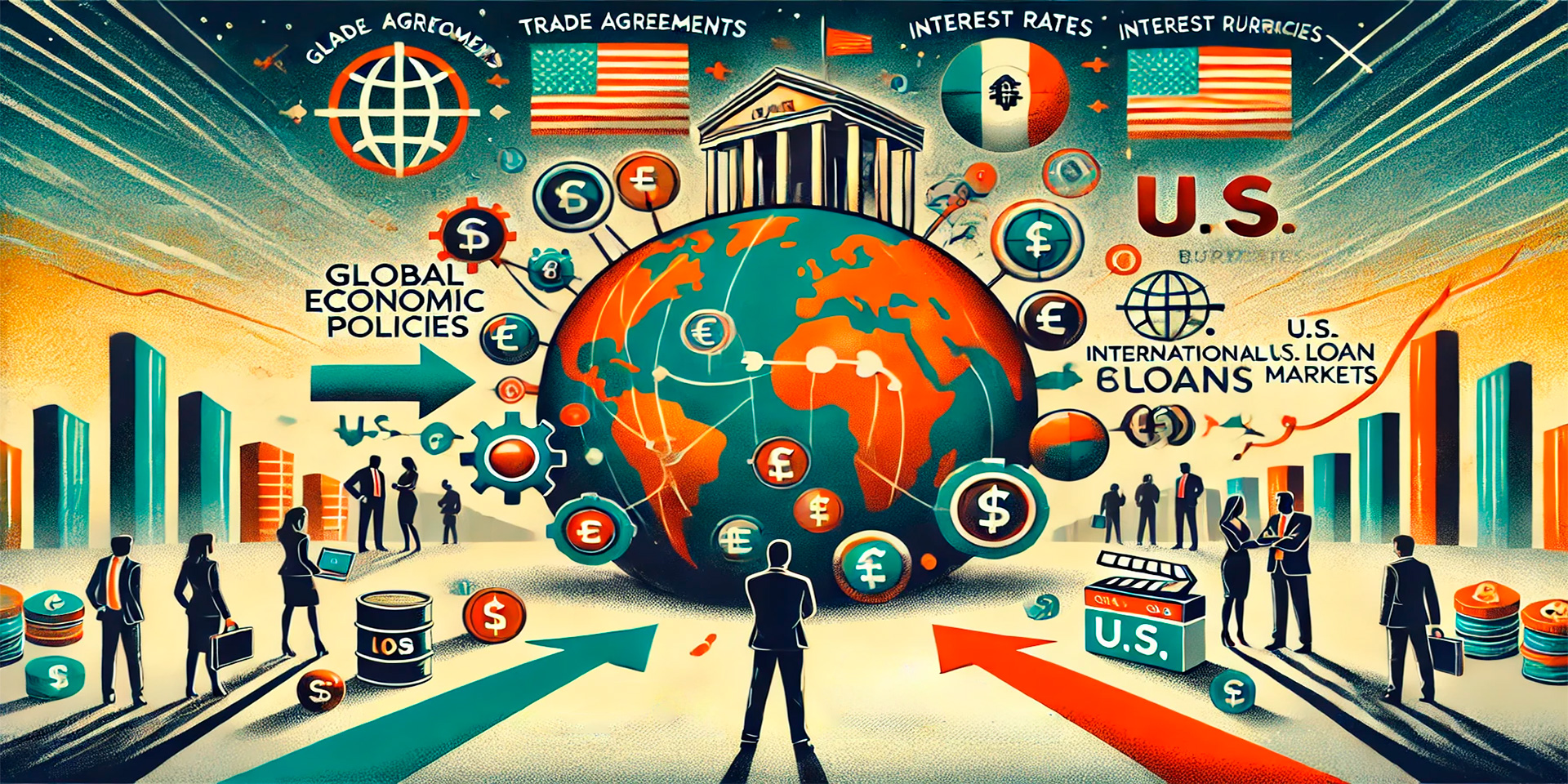
How Global Market Trends Impact Business Loan Conditions
Loan terms are influenced by various factors, with international economic conditions playing a significant role in determining interest rates, repayment structures, and loan availability. Global economic shifts, such as changes in inflation, foreign exchange rates, and international trade policies, can lead to fluctuations in borrowing costs and affect the overall terms of business loans. For companies that operate on a global scale, understanding how these international factors influence loan terms is crucial for managing debt and financing growth effectively.
Businesses, especially those with cross-border operations, must remain attuned to global economic trends that shape credit markets. As international markets shift, so too do the loan conditions that companies depend on to fund operations and expansion.
Interest Rates and Global Monetary Policy
One of the most direct ways that international economics affect loan terms is through global interest rates, which are largely influenced by the monetary policies of major central banks. When central banks, such as the Federal Reserve in the U.S. or the European Central Bank, adjust interest rates, it creates ripple effects across global lending markets. An increase in interest rates usually leads to higher borrowing costs, making loans more expensive for businesses.
These changes are often a response to macroeconomic factors like inflation or currency volatility. When inflation rises, central banks typically raise interest rates to control economic growth, which in turn increases the cost of borrowing for businesses. On the flip side, when global economies are sluggish, central banks may lower rates to encourage lending and stimulate growth, offering businesses more favorable loan terms.
For companies that rely on international financing or operate in multiple countries, the variability of interest rates across regions can significantly affect borrowing costs. Monitoring global interest rate trends helps businesses anticipate changes in loan terms and plan accordingly.

The Impact of Foreign Exchange Rates on Loan Repayments
Foreign exchange rates also play a crucial role in shaping loan terms, especially for businesses that borrow in one currency and generate revenue in another. Fluctuations in exchange rates can dramatically alter the cost of repaying loans. A loan that appears affordable at the time it’s taken out may become much more expensive if exchange rates shift unfavorably.
For example, a business that borrows in U.S. dollars but operates in a country where the local currency weakens against the dollar will face higher repayment costs. This is because it will take more local currency to pay off the same amount of debt. Conversely, if the local currency strengthens, the loan becomes cheaper to repay.
Businesses can mitigate some of the risks associated with foreign exchange rate fluctuations by negotiating loan terms that include hedging strategies, such as forward contracts or options, to lock in favorable exchange rates. Understanding how exchange rate volatility impacts loan repayments allows businesses to better manage cross-border debt obligations and avoid unforeseen financial burdens.
Global Trade Policies and Their Influence on Loan Terms
International trade policies, tariffs, and geopolitical events can also influence the terms of business loans. When trade relations between major economies shift—such as during trade wars or the imposition of tariffs—lenders often adjust loan terms to reflect the increased risks. A more protectionist trade environment can lead to higher borrowing costs, stricter repayment terms, or reduced access to credit for businesses that rely on cross-border operations.
For instance, a global company operating in both the U.S. and China might face higher loan rates if trade tensions between these countries increase. Lenders could perceive the heightened risk of supply chain disruptions or fluctuating demand, leading them to tighten credit conditions. In contrast, when global trade flows smoothly, lenders may be more willing to offer favorable loan terms, as the risk of economic disruption is lower.
Businesses that engage in international trade must remain aware of global trade policy shifts and how these shifts might impact their loan agreements. By anticipating the effects of trade policies on loan terms, businesses can be better prepared to navigate financial challenges and maintain stability in times of uncertainty.
Global Inflation and Its Effect on Business Loans
Inflation is another key international economic factor that influences loan terms. When global inflation rises, central banks often respond by increasing interest rates, which raises the cost of borrowing for businesses. For companies with outstanding variable-rate loans, this can lead to higher monthly payments and increased overall loan costs.
Inflation also affects the purchasing power of money, which can lead to higher operating costs for businesses. As expenses rise, it can become more difficult for companies to meet their loan repayment obligations, especially if their revenue does not keep pace with inflation. In contrast, during periods of low inflation, businesses can often secure loans with more favorable terms, as interest rates tend to remain low, making borrowing more affordable.
For businesses operating in countries with high or volatile inflation rates, it is important to structure loan agreements in a way that protects against sudden increases in interest rates. This might include negotiating for fixed-rate loans or incorporating inflation-adjusted terms to mitigate the impact of rising prices on debt repayments.
Geopolitical Instability and Its Impact on Credit Availability
Geopolitical instability, such as conflicts, political unrest, or sanctions, can significantly affect the availability and cost of credit for businesses. Lenders are typically more cautious during times of global uncertainty, and they may tighten lending conditions or raise interest rates to offset the perceived risks. This can make it more difficult for businesses to secure loans or result in less favorable loan terms, such as shorter repayment periods or higher collateral requirements.
For businesses that operate in politically unstable regions, the risk of fluctuating loan terms is particularly acute. Companies may face sudden changes in credit availability or find that lenders are unwilling to extend additional financing due to heightened risks. Additionally, sanctions or trade restrictions imposed on certain countries can further complicate access to international credit markets.
To navigate these challenges, businesses must stay informed about global geopolitical developments and maintain strong relationships with multiple lenders across different regions. Diversifying funding sources and developing contingency plans can help companies weather periods of instability and continue to secure financing when needed.
Conclusion
International economics has a profound impact on the loan terms businesses face. From interest rates shaped by global monetary policies to the influence of foreign exchange rates, trade policies, and inflation, a wide range of global factors can affect borrowing costs and repayment structures. By understanding these international dynamics and incorporating them into their financial strategies, businesses can better navigate the complexities of global lending markets and secure favorable loan terms that support their growth.

